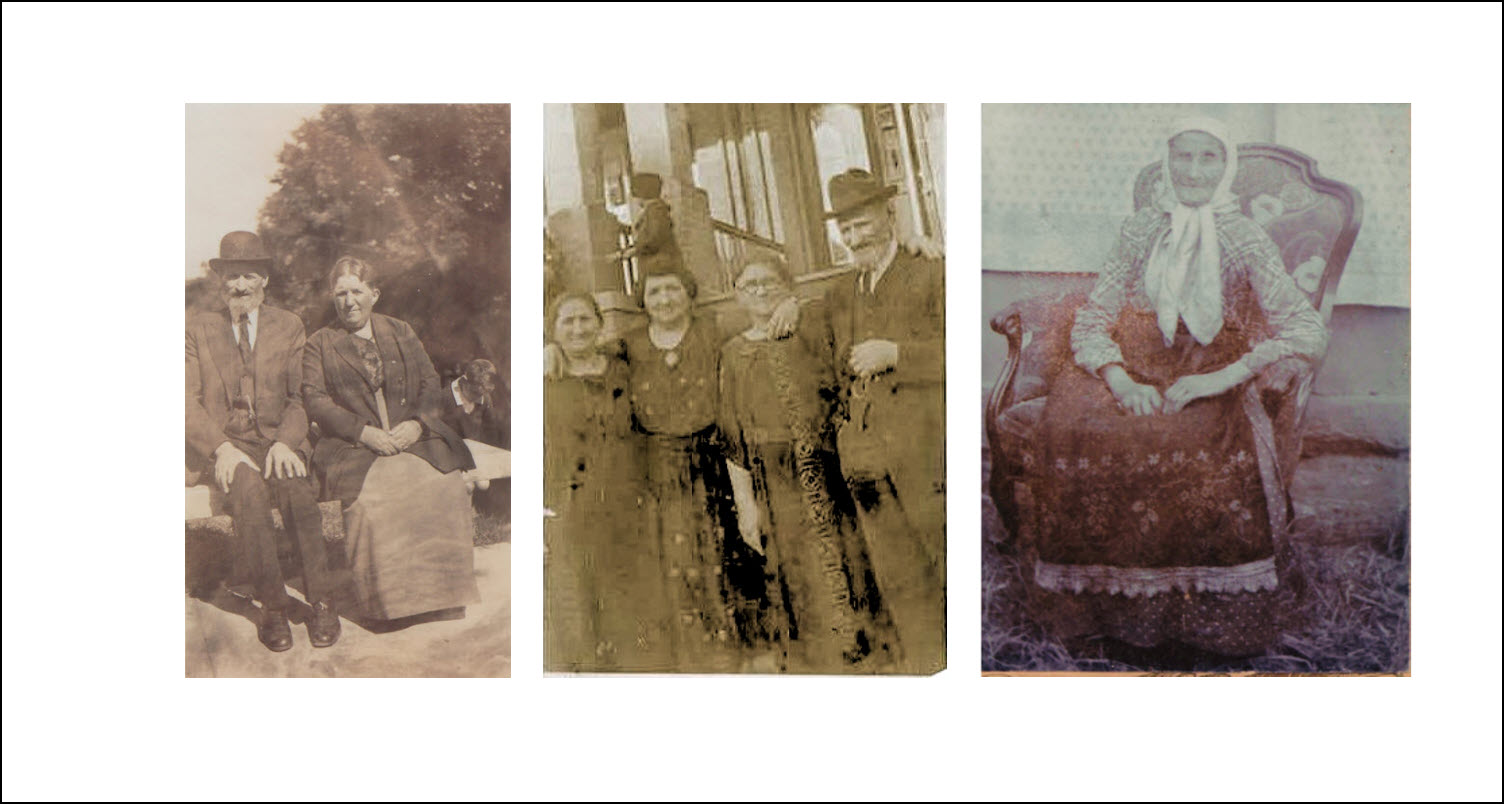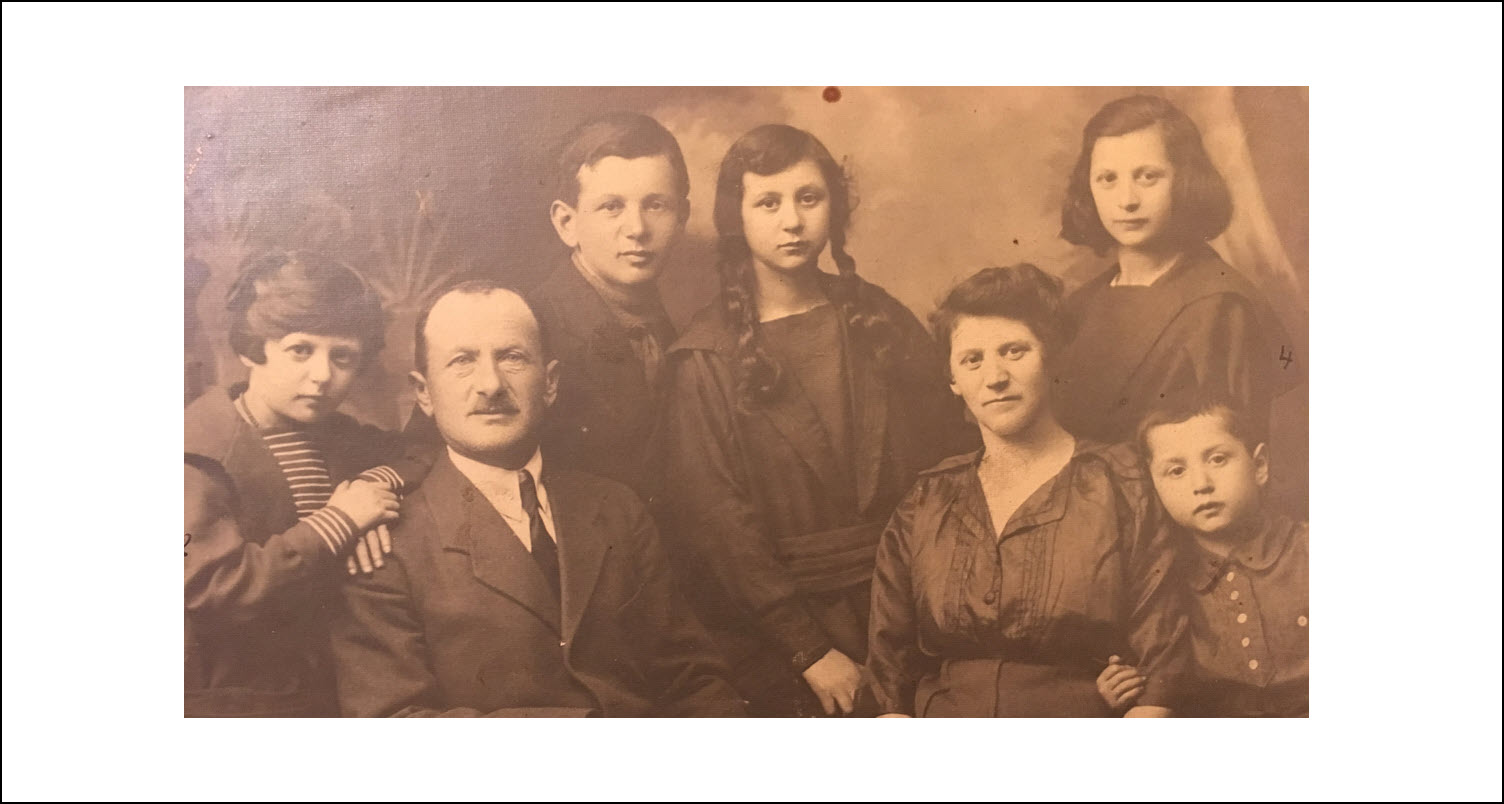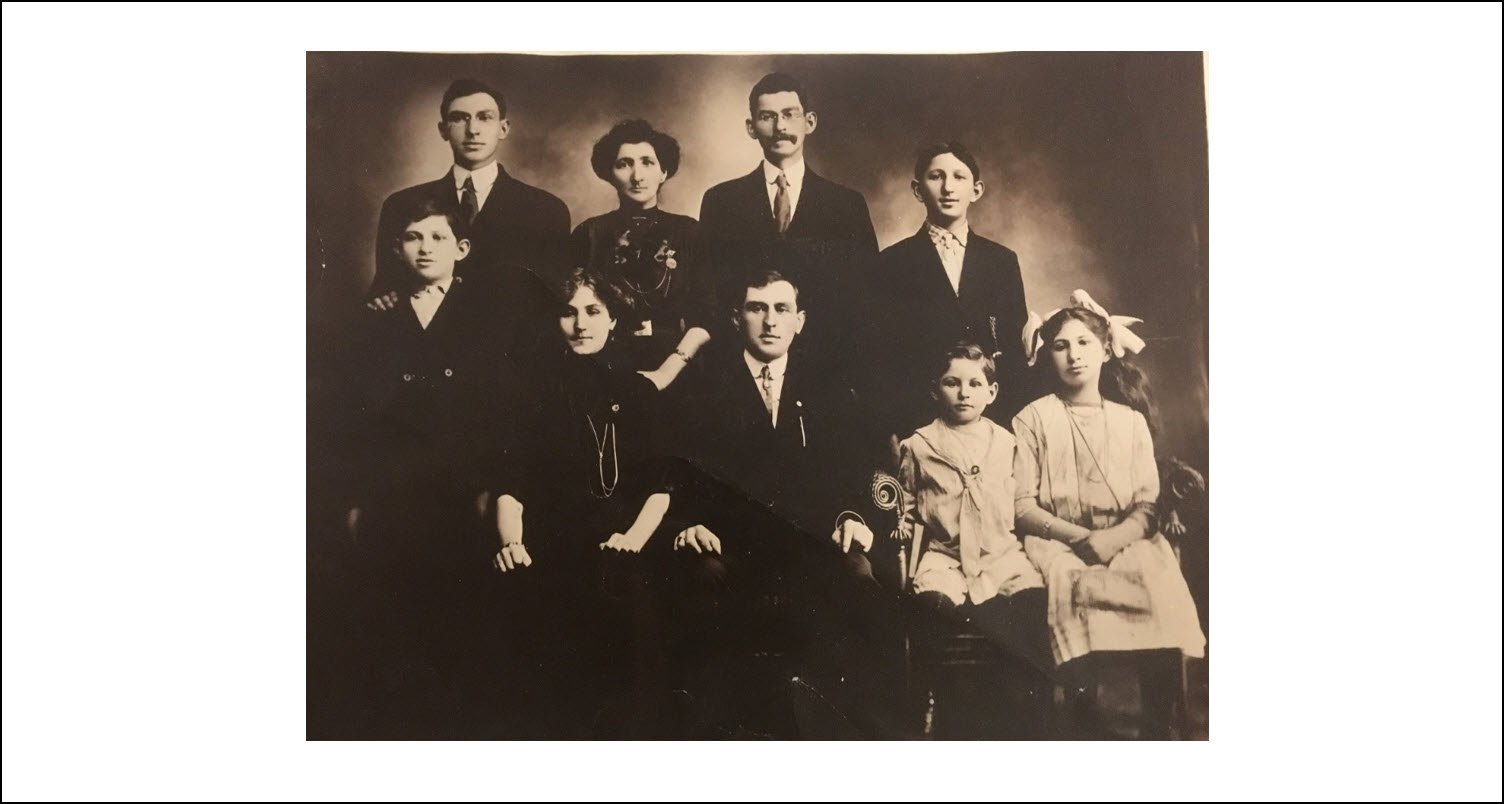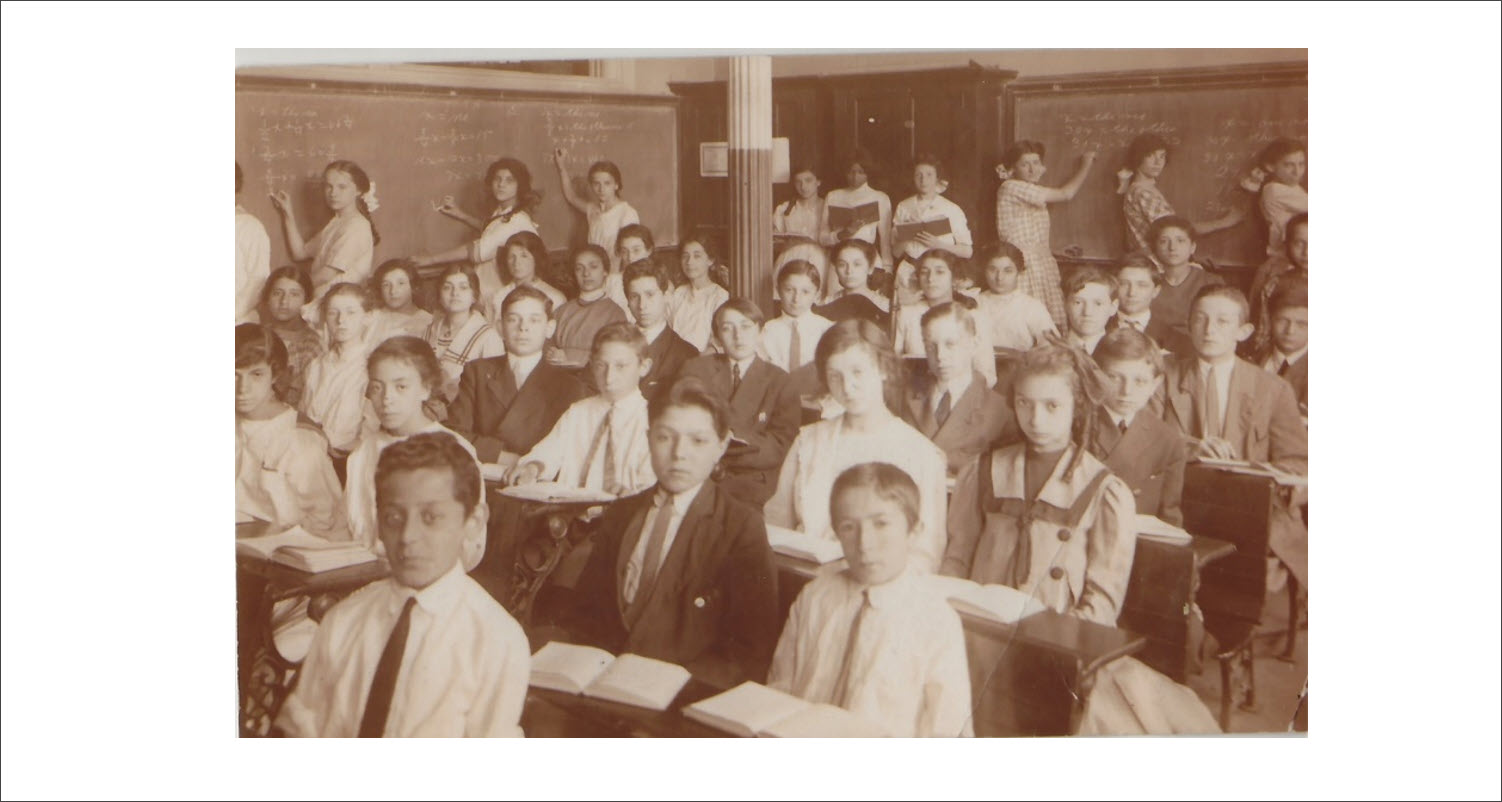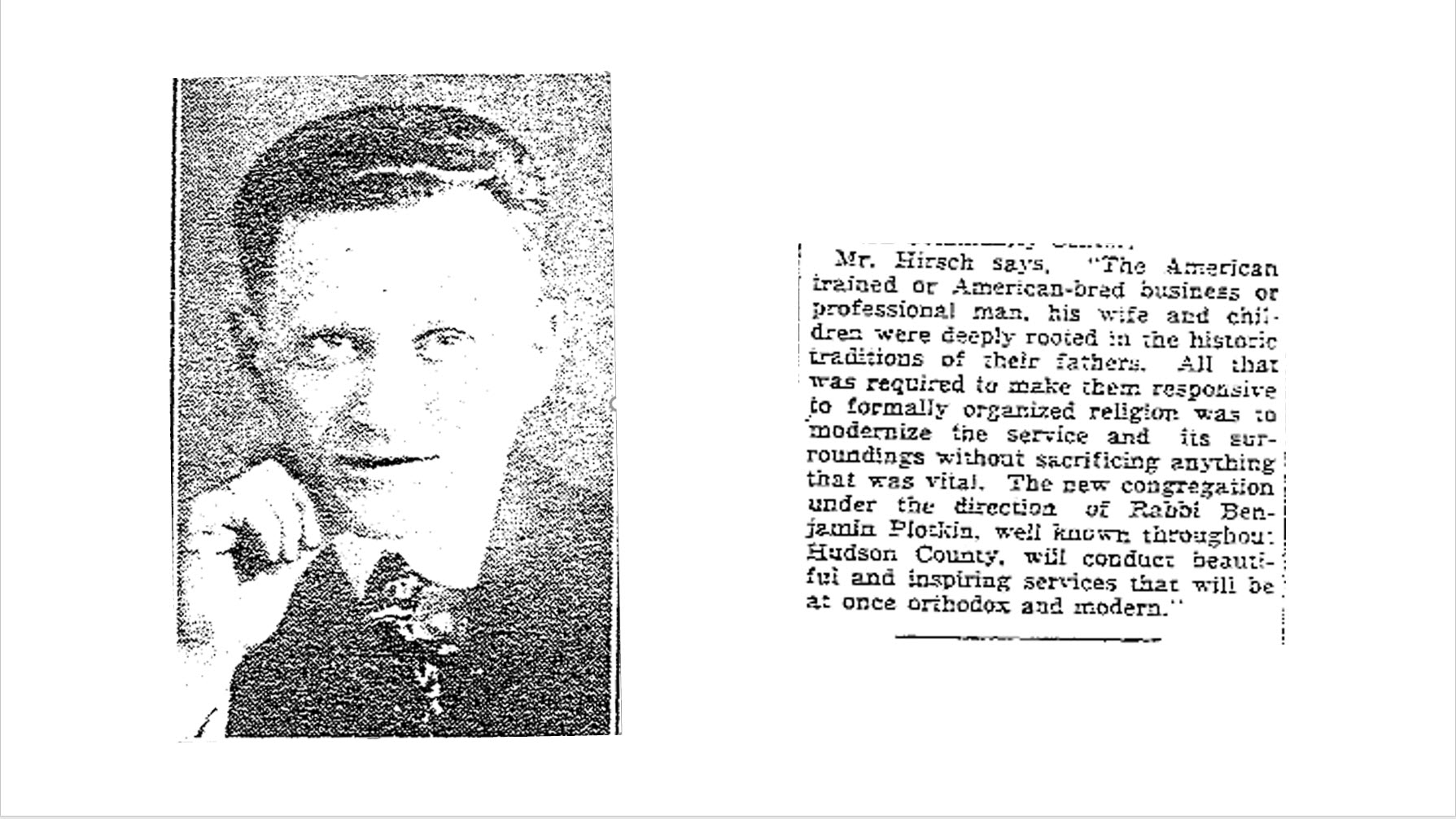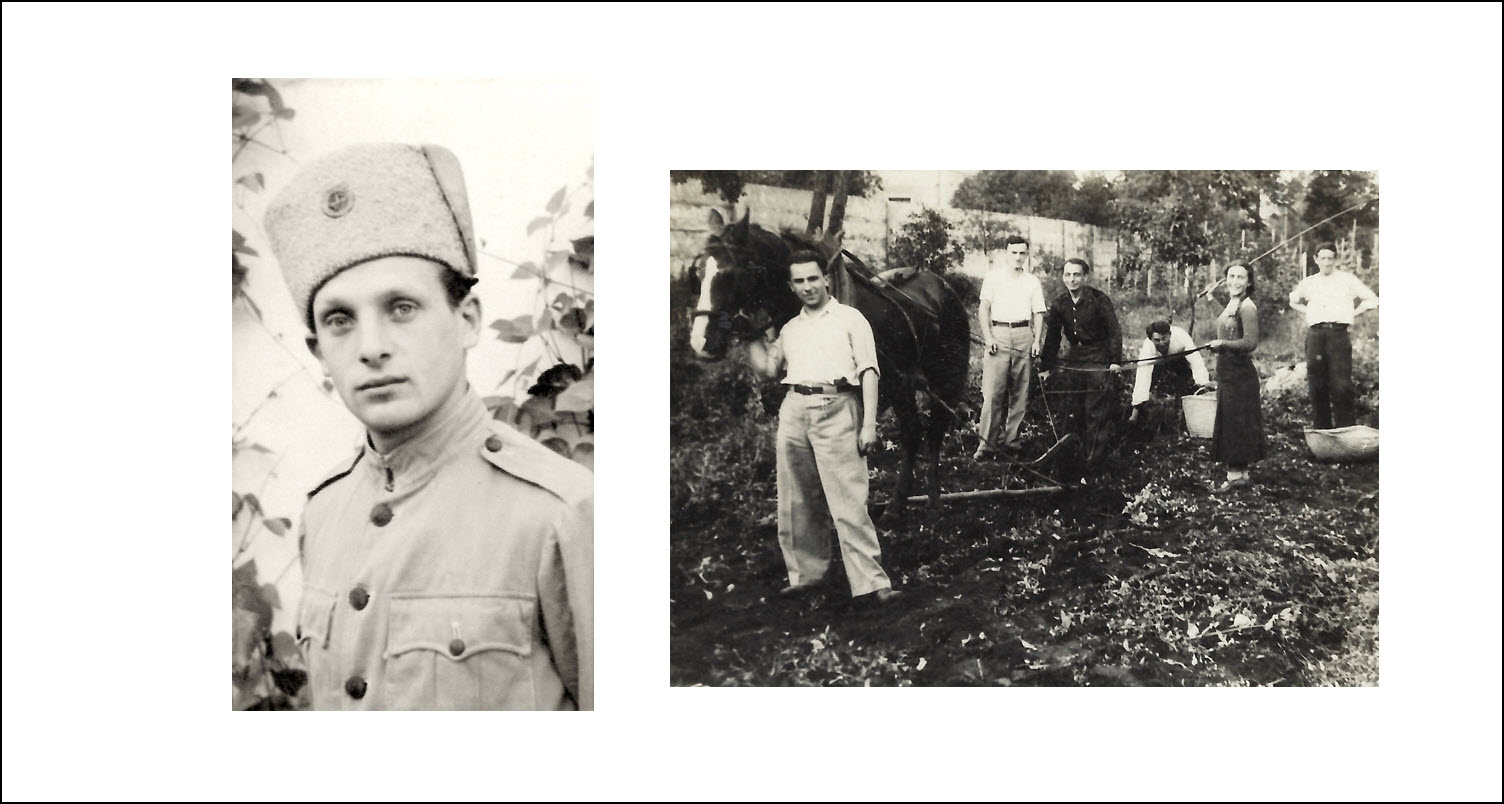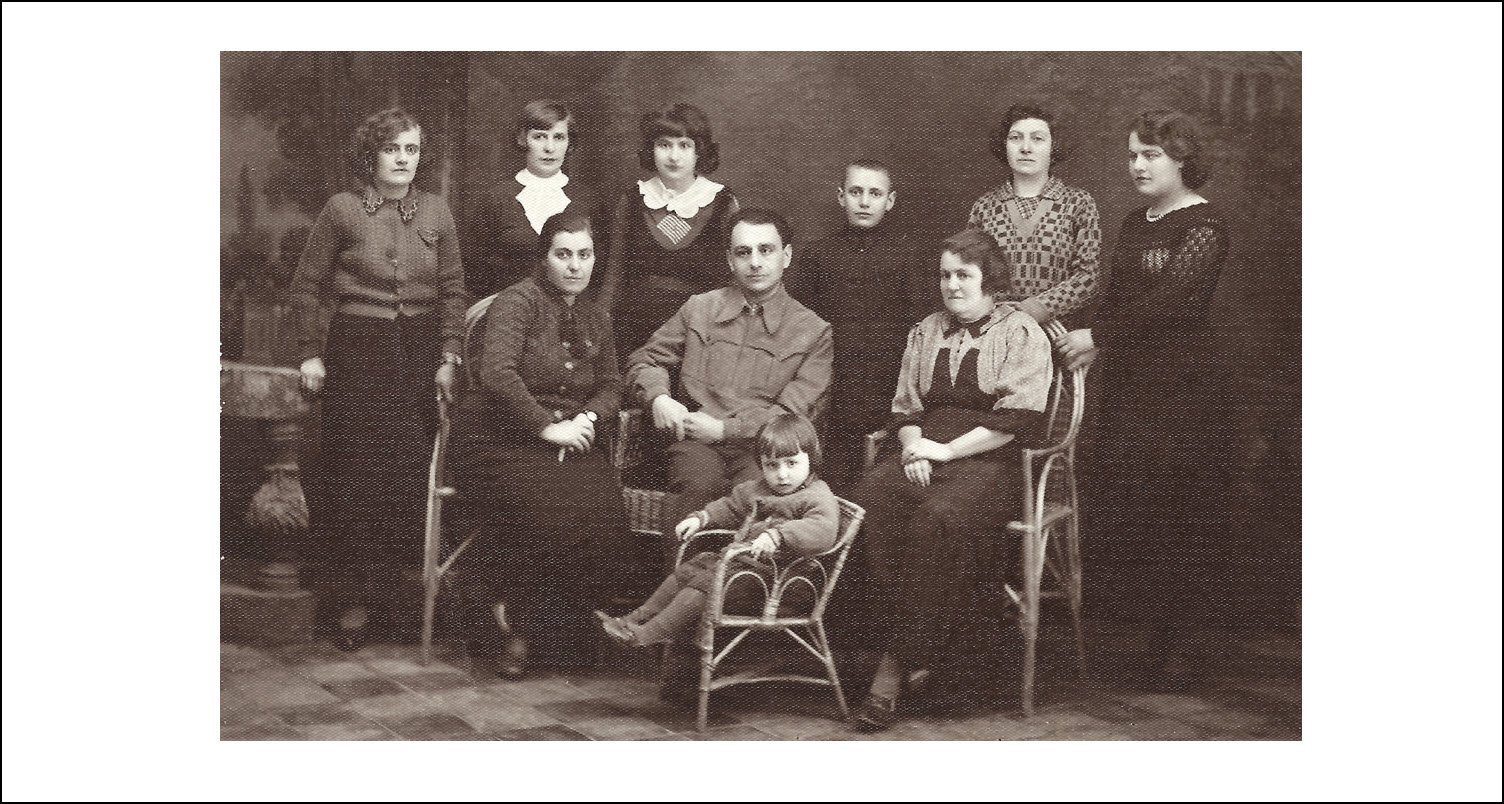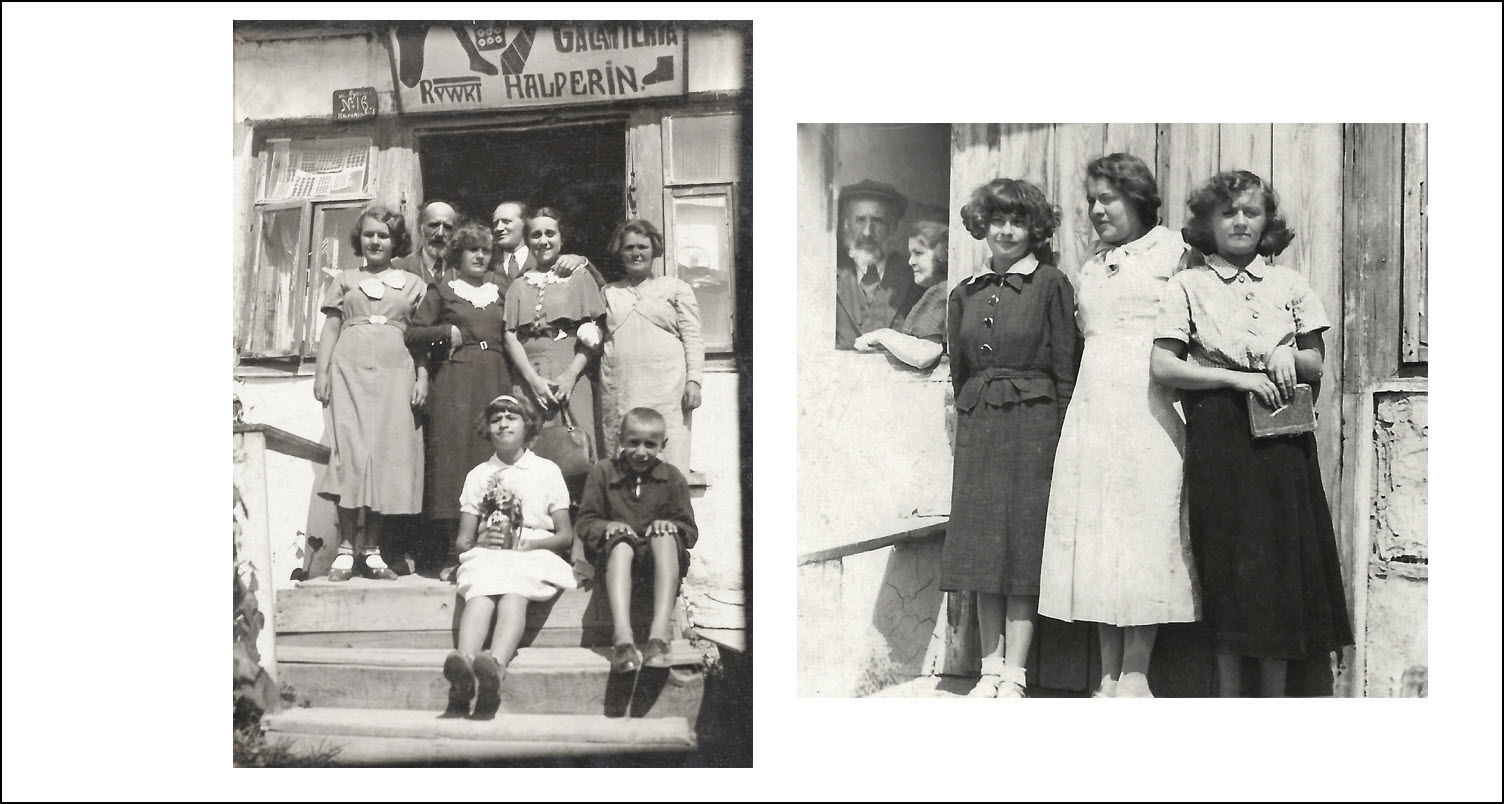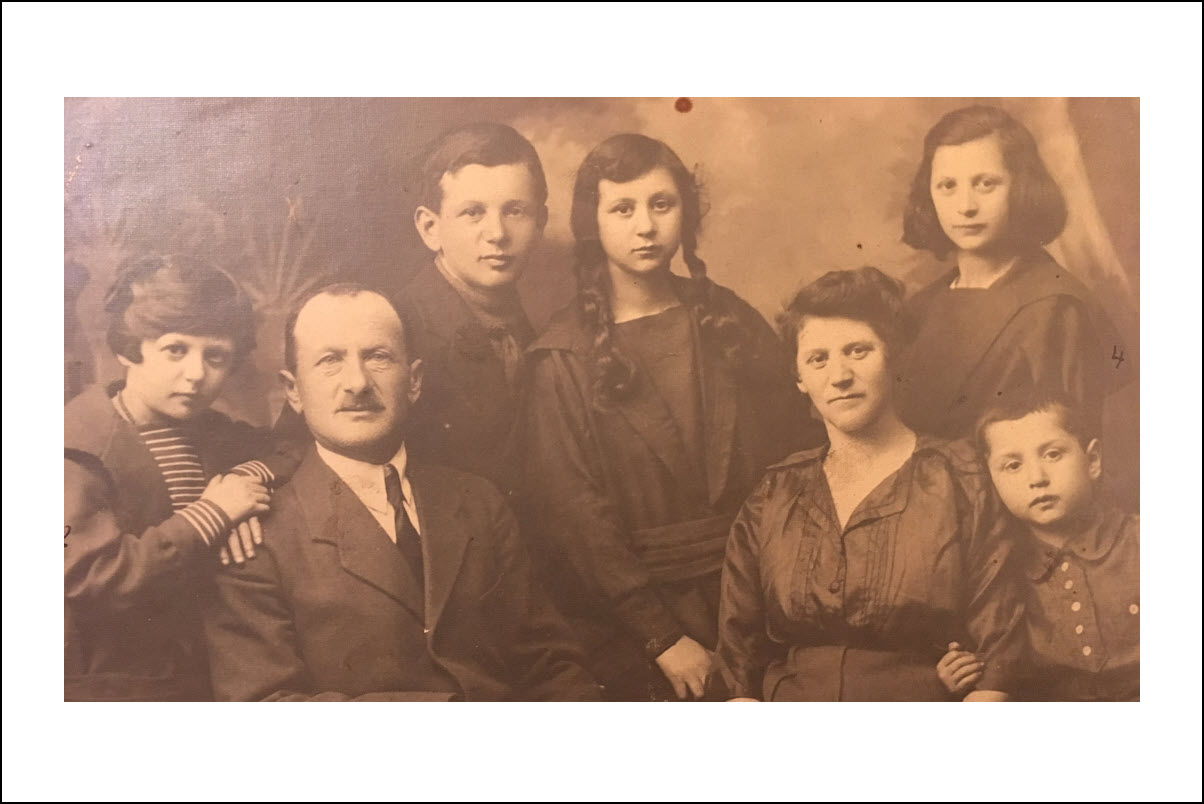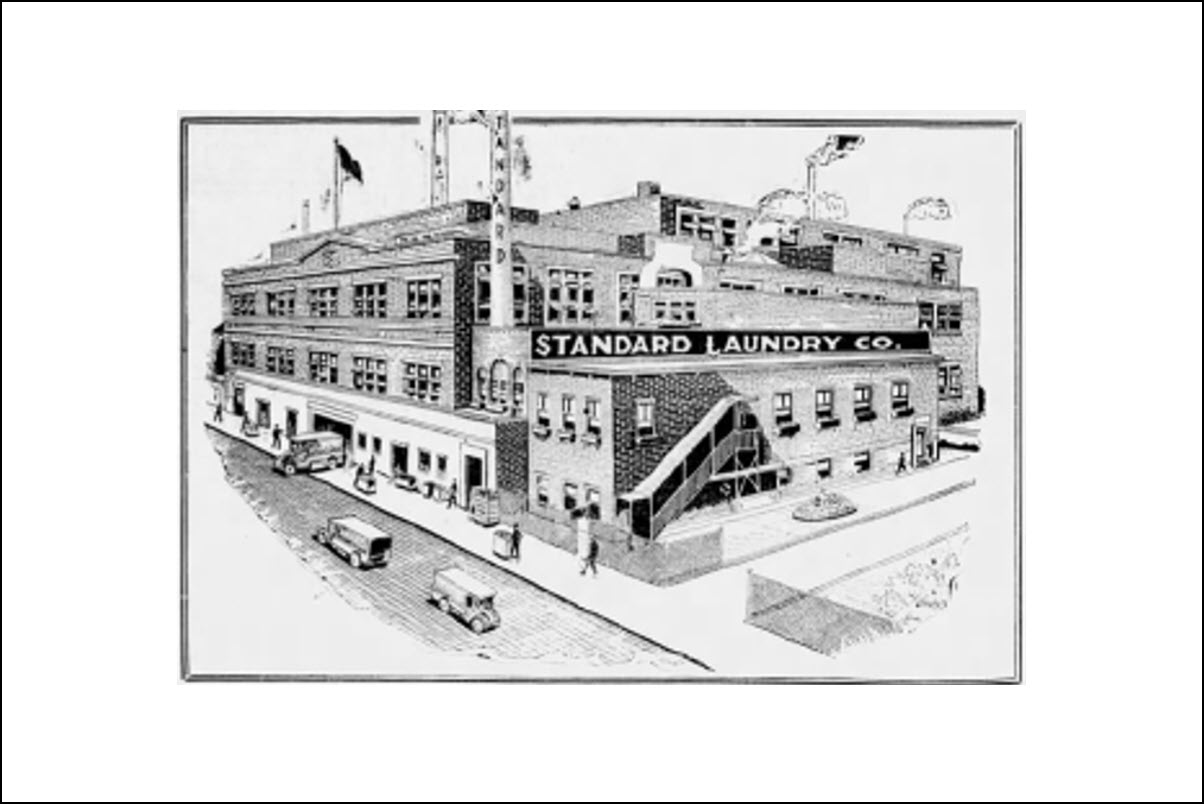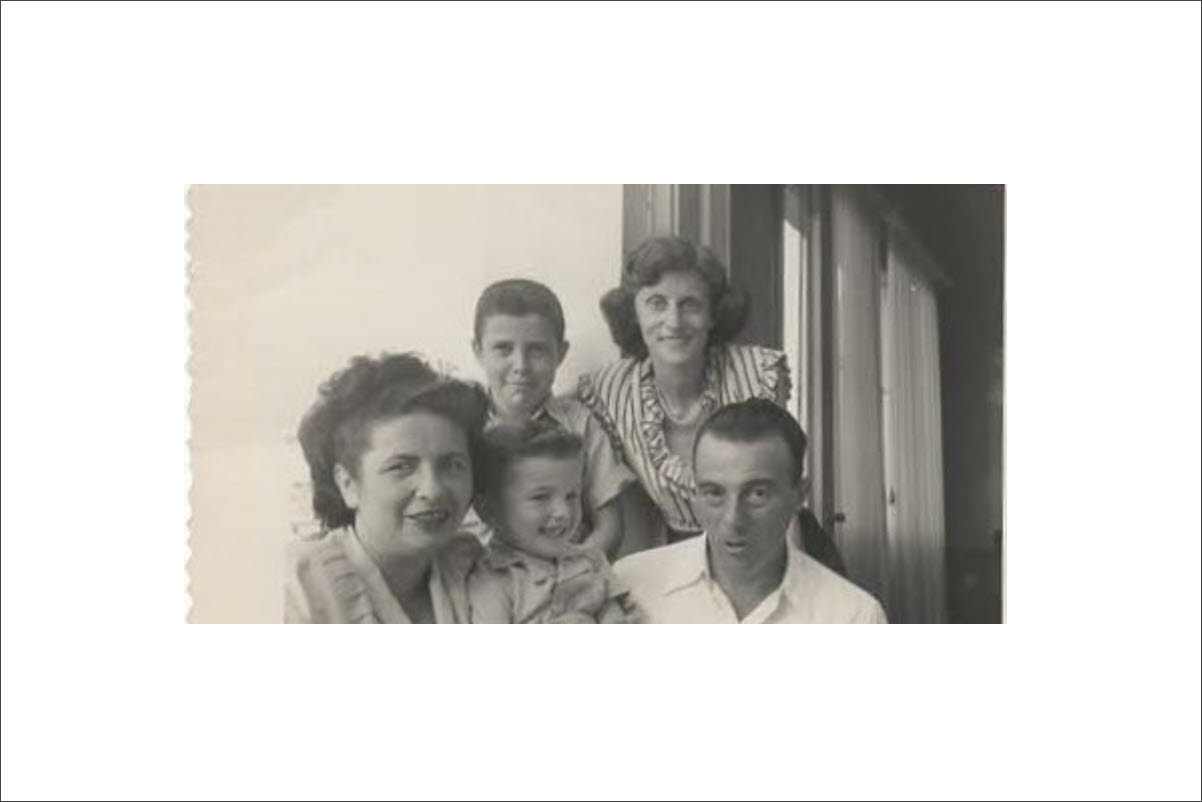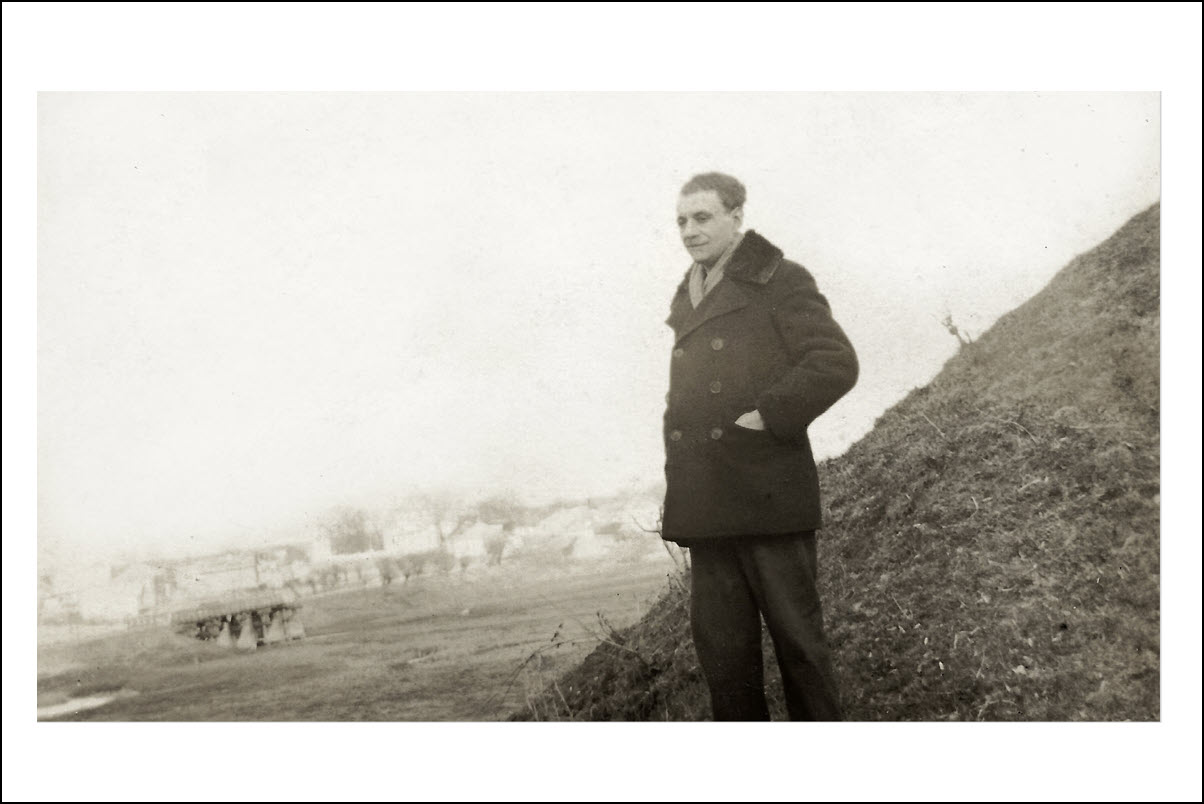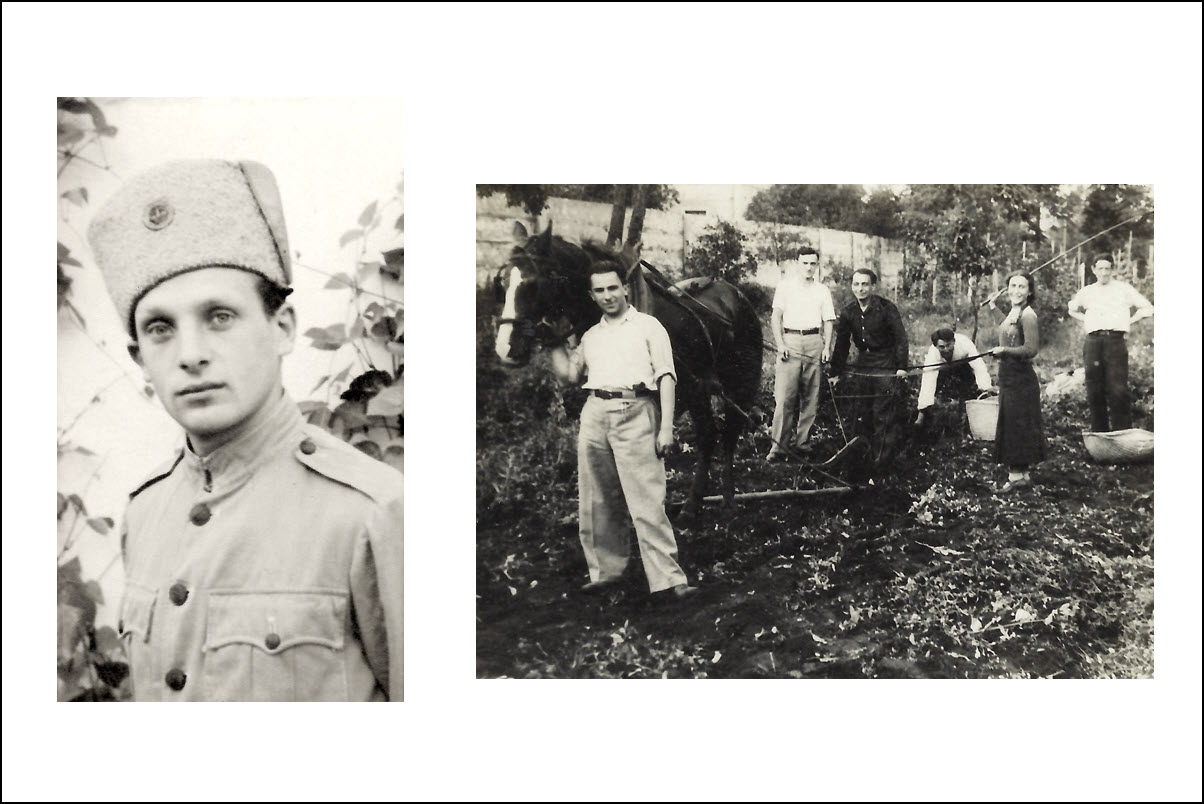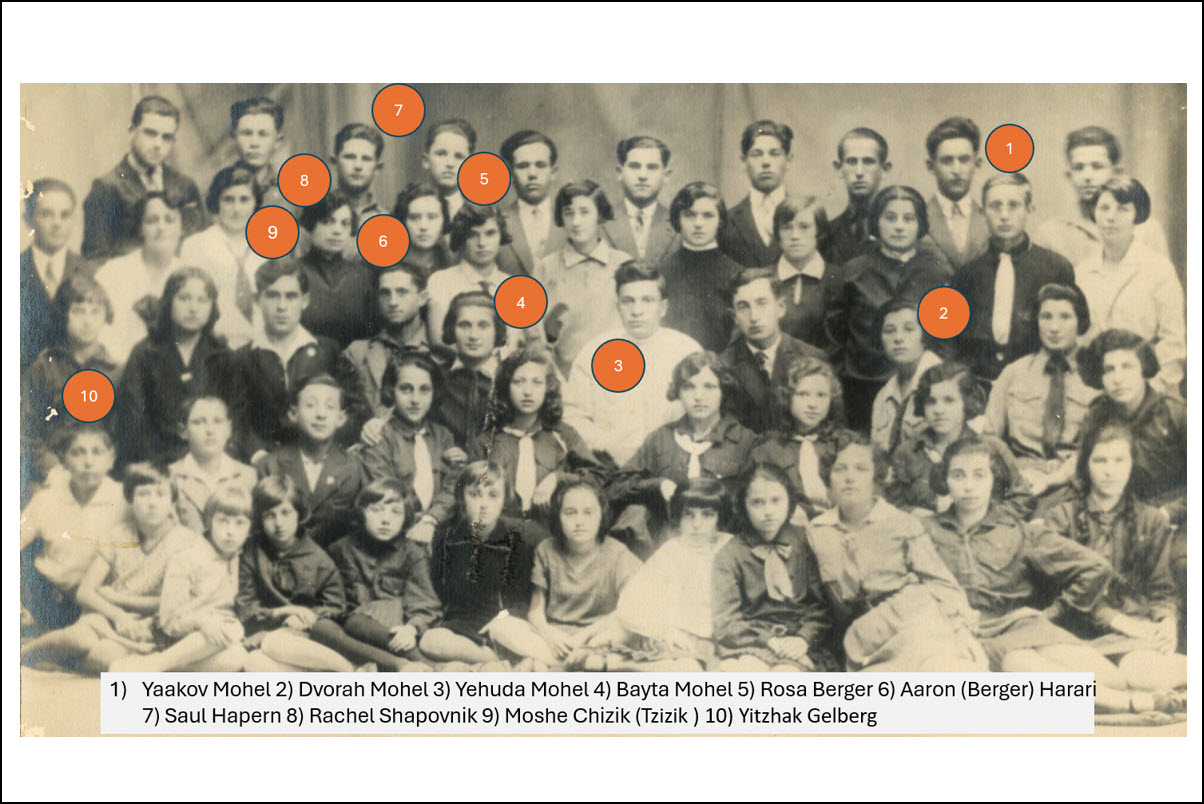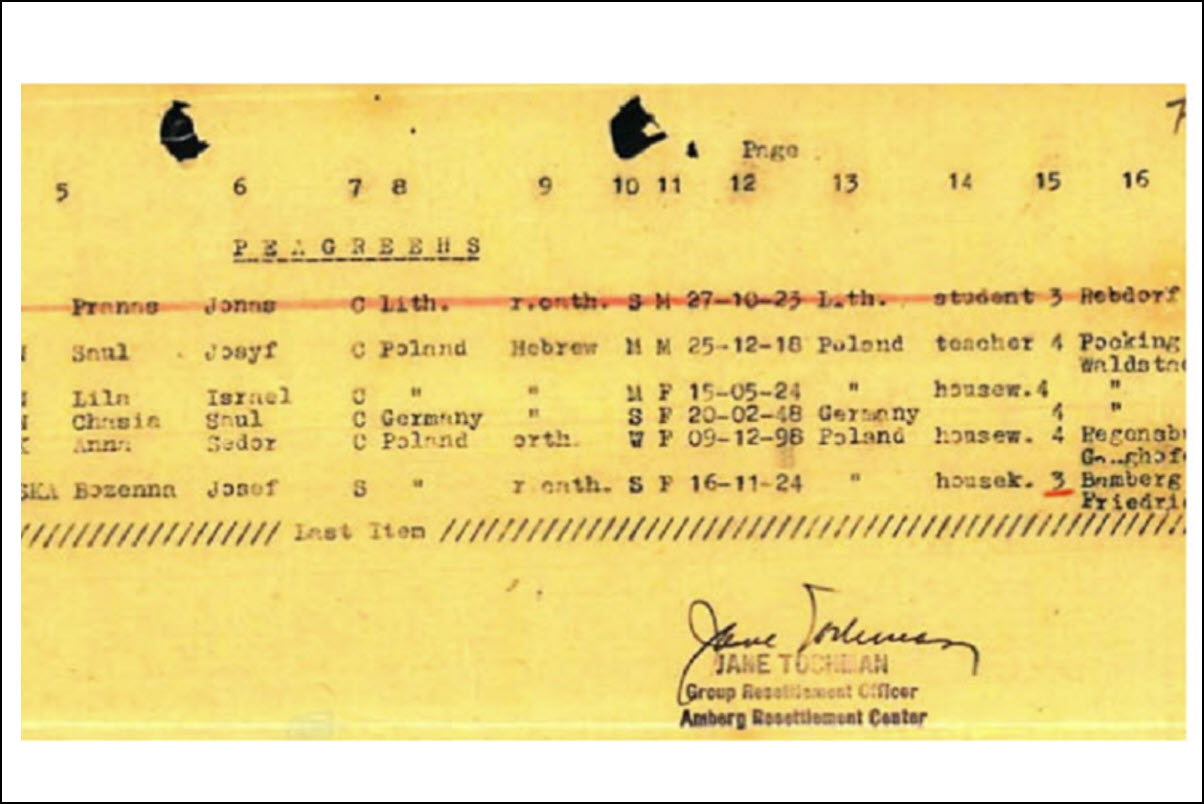-
Home
Home About Network
- History
Nostalgia and Memory The Polish Period I The Russian Period I WWI Interwar Poland WWII | Shoah 1944 Memorial Commemoration- People
Famous Descendants Families from Mlynov Migration of a Shtetl Ancestors By Birthdates- Memories
Interviews Memories 1935 Home Movie in Mlynov 1944 Memorial Commemoration Commemoration Wall- Other Resources
The Hirsch Family from Mlynov

***
(Back to the beginning ...)
The Hirsch Family Story (continued)
The patriarch of the Hirsch family is remembered as a man named Aaron (Aron) Hirsch who married a woman named Liebe. He appears to be the "Aron Irsch," age 32, who appears in household #24 in the 1858 revision list for Mlynov married to a wife Liba, age 30. Since the family is not listed in the earlier 1850 revision, it appears that they arrived in Mlynov between 1850 and 1858.
Aron Irsch is listed in 1858 as the head of household with an implied birthyear of 1826. Aron's father's name in the record is "Gershko" and Aron is also called "Aron Gershko" in this document. Aron's father's name, "Gershko," probably was the origin of the family's surname "Hirsch," since in Russian at the time the "H" and "G" sounds were indistinguisable and interchangeable (other examples from Mlynov: Goldseker/Holtzeker and Gelman/Helman). The record shows that in 1858 Aron and Liba have one son Mordko, age 12, with an implied birth year of 1846. He is possibly the man remembered later by descendants as Moishe Hirsch.
In addition to Morko (Moishe) Hirsch who was born before 1858, we know from descendants and records that Aaron and Liebe had six other children in Mlynov: Daniel (circa 1847-1866), Ephraim (1862–1929) Pessia (1864–?), Zelda (1865–1938), Henie (Anna) (1875–?), and Clara (1879–1962).
Four of the the Hirsch children (Ephraim, Zelda, Henie, and Clara) migrated with families to the US as discussed below. Of the other families who stayed behind in Mlynov (Moishe's and Pessia's), a few of their offspring got involved in the Zionist Youth movement and were able to get certificates to make aliyah to Palestine in the 1930s; almost all of the rest were killed in the liquidation of the ghetto in 1942. The one survivor, Saul Halpern, made his way to Toronto, Canada and settled there.
As I was working on the Hirsch family story, I discovered that in the small town of Mlynov which didn't have much use for surnames, Aron and Liebe's children were described and remembered instead by their first name followed by "Ahreles," a Yiddishism meaning, "Aaron's [child]." The first clue was the caption under a photo in the Memorial Book of Henie/Anna Hirsch in New York (see p. 500). Her married name was Anna Katz and her son became the respected Yiddish poet Aleph Katz. The Memorial book caption describes her as "Henya Ahreles" (meaing Aaron's (daughter) Henya).
A fascinating and troubling essay in the Memorial book is thus about Aaron's son Daniel. The essay called "A True Event in Mlynov from 96 Years Ago," begins by mentioning the large Ahreles family that included Daniel Ahreles, Pessia Ahreles, Henya Ahreles, etc. The essay tells the story of Daniel Ahreles' murder. According to that story, "Daniel Ahreles" lent money to a Czech family and was murdered when he went to collect it. His body was subsequently recovered the next day by the side of the road, but his fur hat was missing. Daniel became a ghost who walked the streets of Mlynov and came in dreams and told residents where they could find his fur hat which was missing. They did indeed locate his hat and bury it with his body. His ghost no longer appeared after that.
At the time Daniel was murdered his wife was pregant. She gave birth to a son after her husband died and named him for his deceased father. I discovered the manifest of that son, called Daniel Hirz, arriving in the US in 1926. Given the age of the younger Daniel, it appears his father was murdered around 1866.
Before the large Hirsch migration to the US, all of the Hirsch children had married and had begun families of their own in Mlynov.
The Children and Grandchildren of Aaron and Liebe Hirsch Children Spouse # of Children Grandchildren Moishe Hirsch (1846–?) Bluma Fischmann (?–?) 1? Esther (?– ?) Daniel Hirsch (circa 1847–1866) Dwoira (?–?) 1? Daniel (1846– 1961) Ephraim Hirsch
(1862–1929)Gitel Kolter (1863–1915) 5 Isaac Hirsch (1879–1973) | Ruchel Leah (Ruth Gurtin) (~1881–1960) | Abraham "A. D." Hirsch (1881–1975) | Harry (Hersch) Hirsch (1884–1986) | Jacob (Gedalie) Hirsch (1889–1981) | Lewis Albert "Abe" Hirsch (1897–1975) | Jeannette "Jennie" Levine (1899–1967) Pessia Hirsch (~1864–?) Lipa Halperin (?–?) 5 Yosel (Joseph) (1880– ?) | Israel (1882–1942) | Avraham (1924–1942) | Sarah (?–? ) | Faiga (?–? )| Chaya Leah (?–?) Zelda Hirsch (~1865–1938) Ben Zion Berger (1865–~1912) 4 Eva (Chava) Neistein (1884– 1947) | Nathan ("Nuhim") (1889–1958) | Sara (Sheindel) Berger (1892–1972) | Samuel (Symon) (1894–1986 ) Anna (Henie) (1875–?) Chaim (Hyman) Yeruchim Katz (1872–?) 5 Shifre (Sophie) Cohen (1893–1982) | Samuel B (1895–1969) | Aleph (Morris/Moshe) (1898–1969) | Helen Goldstein (1904–1997 ) Clara (Chaya) Newman (~1879–1962) Jacob (Yankel) Newman
(1871–1941)5 Leo H (Hyman) (1896–1970) | Harry B (1898–?) | Sophie Mendelsohn Lehmann (1902–1995) | Benjamin (1906–1989) | Leo (Leon/Leonard) (1915–? ) ***
The Hirsch Migration To America
The sons of Ephraim and Gitel Hirsch were the first movers in the migration to America. Hersch (Harry), age 22, arrived in July 1905, followed by Jacob "Gdalie Girsch" in December 1906 and Abraham "A. D." in August 1907. In 1907, two of the Hersch's uncles also arrived: Jacob Newman (Clara Hirsch's husband) and Chaim Yerukim Katz (Anna Hirsch's husband). Chaim Yerukim was also accompanied by his eldest daughter, Shifre (soon to be Sophie Katz and then Sophie Cohen).In July 1909, the eldest of the brothers, Isaac ("Eisik Girsch"), age 30, followed his brothers to the US leaving behind his wife, Sure (Kypher later Cooopersmith) and four children who wouldn't join him until 1912. In December 1909, five months after Isaac arrived, the Hirsch brothers were finally joined by their parents, Ephraim, age 48 at the time and Gitel, age 47, and their two youngest siblings: Abe (Lewis), age 11, and "Yeute" (Jennie), age 10. Ephraim and Gitel were traveling together with another young woman from Mlynov, Mollie ("Mali") Shargel, who was the eldest daughter of the Shargel Family from Mlynov and the first of her immediate family to immigrate.
With the arrival of Ephraim and Gitel and their two youngest children in New York, all of their immediate family had made their way to the US with the exception of one daughter, Ruchel Leah, who had married Jacob Gurtin by 1904, when they had their first child, Saul Gurtin (1904–1986). Four other Gurtin children followed: Beatrice (1907– ~1926), Miriam Fidel (1908–2002), Edna Aronson (1912–1995), and Milton (1915–1977). The Gurtin family remained in Europe until after WWI when they finally were able to immigrate and join the family in Jersey City in 1922.
The Hirsch brothers initially lived in the Lower East Side of Manhattan at 86 Lewis St. and stayed with a friend or cousin whose name was something like "A. Waitzer" or "Weizer", but who has not yet been identified. They remained in the Lower East Side until shortly before their parents arrived in 1909 when they moved uptown to 116th in East Harlem. They were not there long and by 1911 moved across from Manhattan to the up-and-coming Jersey City where they acquired an existing laundry business. There they capitalized on the shift emerging in the industry from "steam" laundry to what was called "wet wash." The laundry business now picked up dirty clothes and linens from a family's home, washed them, and then delivered them back to the family still wet, for the wife of the house to hang dry. The innovation in practice significantly dropped the cost of the laundry and made it available to a far great number of families. Advertisements at the time touted the cost-effective, labor saving new approach that improved the lives of housewives, and also leveraged a cleaner more sanitary process. Wet wash laundry took the industry by storm.
By 1930, "Standard Wet Wash Laundry," as the family called it, had grown from the old Sherwood firehouse with two horse-drawn wagons into a modern plant with a fleet of cars and over three hundred workers. During this time, the business supported all of the Hirsch brothers' families, plus a number of cousins such as Aleph Katz, who worked there. By the late 1920s, A. D. Hirsch and his brothers were the largest financial contributors in Jersey City to the new Jewish Community Center, the auditorium of which they named after their mother, Gertrude (Gitel) Hirsch, who had passed away in about 1915.
***
The Arrival of Ephraim's sisters
With Ephraim's family settling into Jersey City around 1911, his sisters and their children began arriving in the US, to rejoin their husbands/fathers who had already arrived several years earlier. Ephraim's sister, Clara Newman, arrived in 1911 with her children and headed to Providence to join her husband Jacob who had arrived in 1907.
Two of Ephraim's other sisters arrived in 1913. His sister, Zelda Berger, now widowed, arrived in May 30, 1913 with two of her daughters, Sheindel (Sara) Berger and Eva Neistein, with Eva's two eldest children. They headed to Chicago to join Zelda's son, Nathan Berger, and son-in-law, Paul (Pinchus) Neistein, who had arrived there earlier. The Bergers were accompanied by other Mlynov travelers, Jacob Wallace, and Ruchel Steinberg; the latter would soon marry Zelda's son, Nathan. The Berger family saga is told in more detail earlier. Arriving six months later was another of Ephraim's sisters, Henie (Anna) Katz, age 38, with her three younger children, Samuel 19, Aleph ("Moische"), 16, and Helen (Chane), 9. They too were finally reunited with her husband, Chaim Yerukim and eldest daughter Sophie (Shifre), who had arrived in 1907.
An overview of the Hirsch family migration Date of Arrival Details July 8, 1905 Hersch (Harry) Hirsch arrives going to 55 Rutgers to "J. Israel" Sept 5, 1906 Harry declares Intention to naturalize while living on 86 Lewis Street Dec. 10, 1906 Gedalie/Jacob arrives going to brother Harry c/o J. Waitzer, 86 Lewis St. May 21, 1907 Uncle Chaim Yerukhem Katz arrives with daughter Shifre, using the last name Fisz (variation of Girz or Hirz) May 22, 1907 Uncle Jacob Newman with Pinchas Neustein headed to 86 Lewis or 86 Division St (or both) c/o Waitzer or Wazer Aug. 21, 1907 Abraham "A. D." arrives headed to brother c/o A Waitzer at 86 Lewis July 15, 1909 Eisik (Isaac) Girsch arrives via Baltimore headed to brother Harry on 86/26 Lewis St c/o J. Waitzer Dec. 14, 1909 The brothers' parents, Ephraim, Gitel, and siblings Abe (Lewis) and Jennie arrive, headed to son, Harry, now at 248 E. 116th. They were traveling with Mlynov-born Mollie Shargel. July 31, 1911 The arrival of Ephraim's sister, Clara "Chaje" Newman, and her four children, headed to her husband Jacob Newman in Providence, RI Aug. 19, 1912 Isaac Hirsch's wife, Sara, arrive with their five children to join her husband who was at 244 E 116th St. in East Harlem. May 30, 1913 Ephraim's sister, Zelda Berger, arrives with two daughters and two grandchildren. They are headed to her son and son-in-law who had already settled in Chicago. Dec. 2, 1913, Ephraim's sister, Anna (Henie) Katz, arrives with her three younger children to join her husband and oldest daughter in New York. Sept. 28, 1922 Ephraim's daughter, "Ruchla Leja" (Ruth) Gurtin, arrives with her husband and five children. They are headed to her father's home in Jersey City. Nov 16, 1926 Daniel Mordko Hirsz, his wife Rachel (Loshak) and daughter Doli arrive. They are headed to Daniel's cousin "Isac Hirsz" at 121 Wegman in Jersey City. 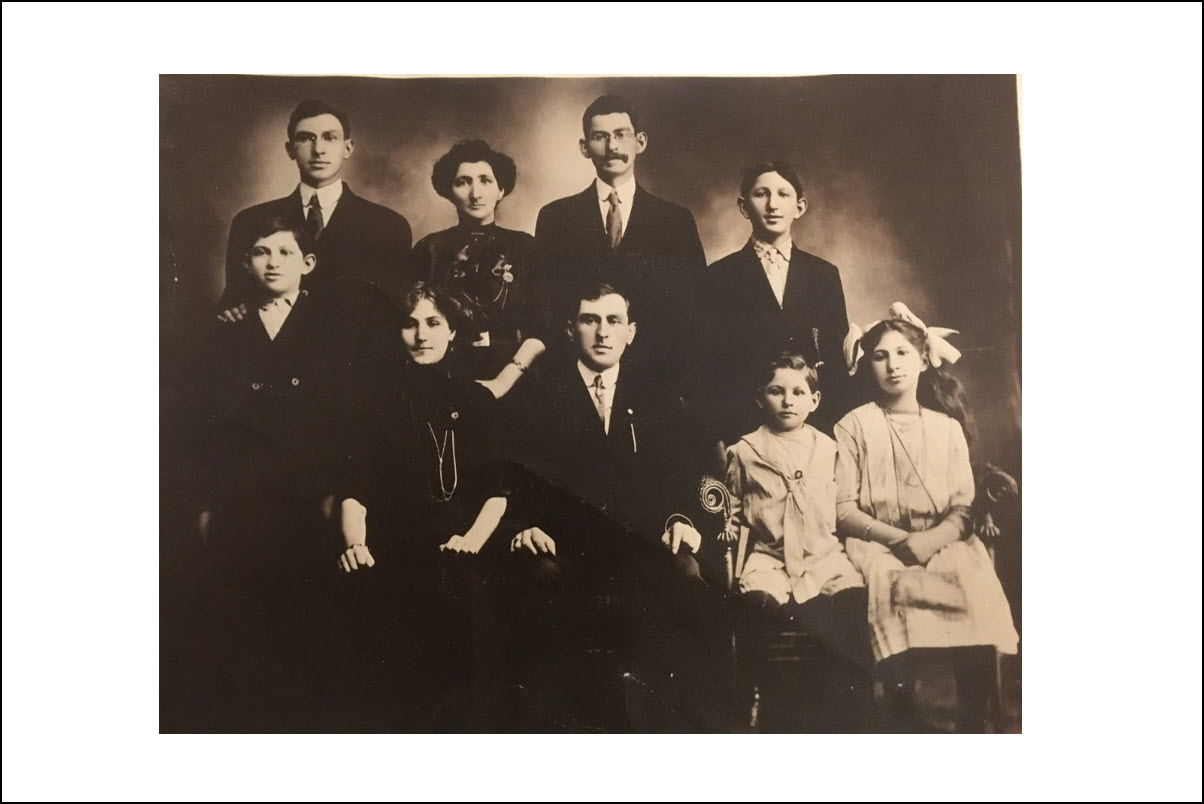 The Newman Family in Providence circa 1912. Standing center: Clara (Hirsch) Newman and husband Jacob Newman and children.[1] Courtesy of Caryle (Newman) Katz.
The Newman Family in Providence circa 1912. Standing center: Clara (Hirsch) Newman and husband Jacob Newman and children.[1] Courtesy of Caryle (Newman) Katz.***
The Last Wave of Migration
During WWI, immigration was no longer possible. Once the war ended, Mlynov became part of the newly recreated Poland and immigration to the US opened up once again. Ephraim and Gitel's daughter, Ruchel Leah Gurtin, and her family made their way to the US arriving in September 1922. At the time of arrival, Ruchel Leah is 40, her husband Jacob is 45, their son Szowel (Saul), 18, Basia (Beatrice) 15, Malka (Miriam) 13, Enia (Edna) 10, and Michel (Milton), 7. Milton who was the youngest of the Gurtins later recalled what it was like getting ready to leave for America for a young boy. He writes:
The preparing for the journey was in itself an adventure. The taking of passport pictures, the selling of the house and of its contents, the hurrying and scurrying about, excited us. Preparations were high for our trip to America. The day before we left will always be fixed in my mind. My friends gathered in a group and we were discussing my prospective journey. One boy predicted that the boat would sink and we would all drown. He exerted all his imagination to paint this scene and by the time he was finished I was terribly frightened.
The others came to the rescue by saying they heard that the streets are paved with gold and silver in America. They ended up in wishing me Bon Voyage and asking me to spare a few gold coins for them. I remember the trip vaguely, - the getting on and off trains, the surge of the crowds around the stations, the hustle and bustle of the larger cities. The journey across the ocean is hazy. A few times I had to take a cold shower of salty water and then was inspected. I dreaded this procedure because the brine would splash into my mouth and eyes leaving a stinging and thirsty feeling. The third class passengers enjoyed their journey better than the first or second. The many songs and dances that filled the air showed their enthusiasm and happiness in the thought of beginning a new life in a new country with every chance of success. At the sight of the Statue of Liberty everyone began to sing, shout, dance, and even to cry for sheer happiness.
***
The Ghost's Son Arrives
There was one additional Hirsch family member who arrived in the 1920s. His name was Morko Daniel Hirsz (soon to be Daniel Hirsch) and he arrived on November 10, 1926 with his wife Rachel (Losak) and daughter, Dolli. He appears to be the son of the Daniel Hirsch who was murdered and became a ghost in Mlynov.
The family somehow made it to the US just in the nick of time before immigration completely shut down. Their immigration in 1926 is the last direct legal immigration of a Mlynov born individual found to date. In fact, the Immigration Act of 1924 substantially curtained immigration from Eastern and Southern Europe by setting quotas based on national origins and limiting the number of new immigrants to two percent of each nationality in the US as of the 1890 national census. Because of these quotas, a number of young men from Mlynov could only get to the US circuitously via Buenos Aires and Mexico between 1923–1926.
Daniel Hirsz was born on July 10, 1886 in Mlynov, which is how we know the likely date his father was murdered. You'll recall the wife of Daniel Hirsch was pregnant at the time. She gave birth to a son and named him after his father. This younger Daniel Hirsch met Rachel Loshak in Rovno (Rivne) where they got married on March 2, 1920 shortly after the end of the War. It seems likely that the dislocation of the War years brought them together at some point in Rovno. Their daughter Dolly (also spelled Dolli) was born there on Oct 22, 1922. They arrived in New York in November 1926 and were headed to the home of their "cousin Isaac Hirsz at 121 Wegman St." in Jersey City.
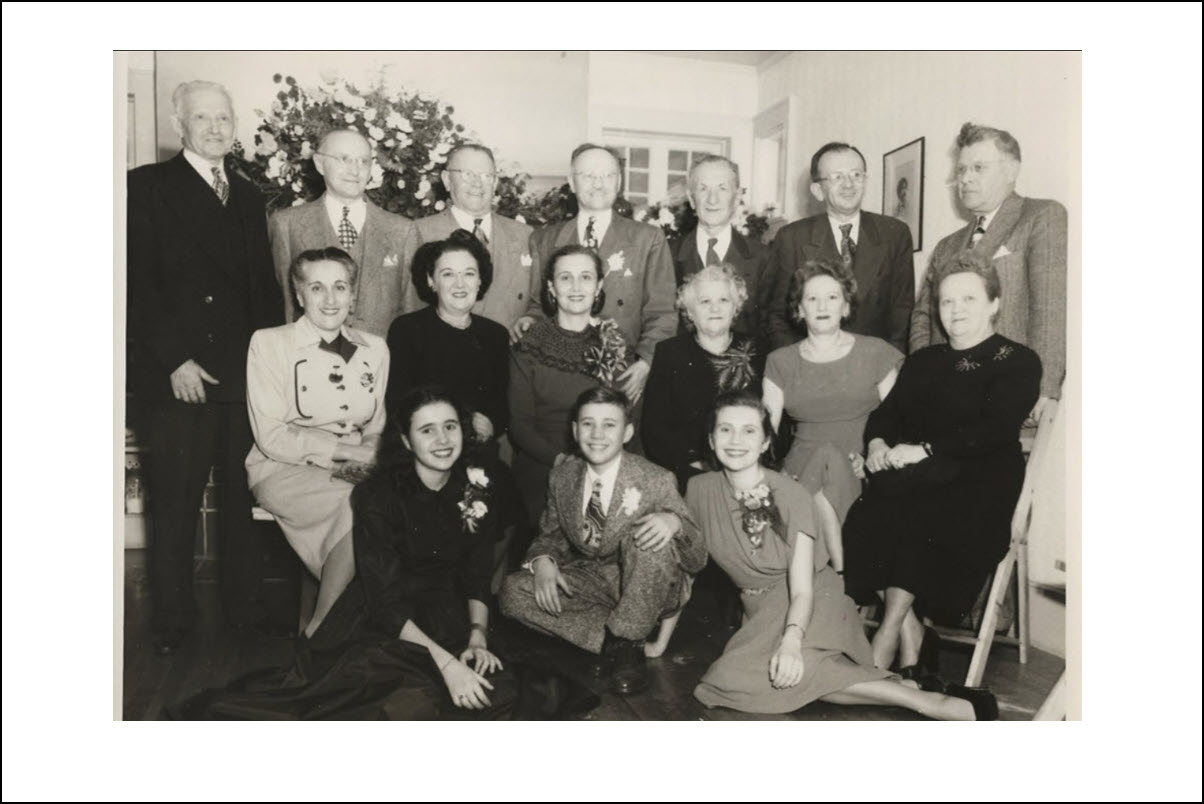 Hirsch Brothers[2] at Edward Hirsch’s bar mitzvah, circa 1947. Courtesy of Deborah Dickmann and Jenny Silverman.
Hirsch Brothers[2] at Edward Hirsch’s bar mitzvah, circa 1947. Courtesy of Deborah Dickmann and Jenny Silverman.***
Back in Mlynov: Lipa Halperin and Luba (Goldenberg) Kravitz
While Ephraim and three of his sisters and their families immigrated to the US, there were still two siblings of Ephraim (Pessia Halperin and Moishe Hirsch) who had remained back in Mlynov. Almost all of of their descendants that we know about were killed in the liquidation of the Mlynov ghetto in 1942. We know the most about Pessia's descendants.
Pessia had married Lipa Halperin before 1882 when they started having their six children: Israel Halperin (1882-1942), Avraham Halperin (1924-1942), Sarah Halperin (?-1942), Yosel (Joseph) Halperin (?-1942), Faiga Halperin (?-1942), and Chaike Halperin (?-1942). These six children in turn produced at least twelve grandchildren whose names have been preserved in family trees. Moishe Hirsch, for his part, married a woman named Bluma and had at least one daughter, Ester. It is not known if they had other children.
Of those thirteen grandchildren, four lived beyond 1942. Two of them (Luba Goldenberg and Lipa Halperin) made aliyah in the 1930s to Palestine. A third, Benjamin, joined or was recruited to the Red Army and married and settled in Russia, and a fourth, Saul "Shaul" Halpern, survived the liquidation of Mlynov. Their names are highlighted in bold in the family tree below and what we know of their stories follows.
The Children and Grandchildren of Pesia (Hirsch) and Lipa Halperin Children Spouse # of Children Grandchildren Chaika Halperin Beryl Goldenberg 5 Luba (Goldenberg) Pesis / Kravitz | Ethel Goldenberg Faiga Halperin Yishayahu ? 5 unknown Sarah Halperin Yalka Schlian 4 Moishe Schilian Yosel (Joseph) Halperin (1889–1932) Tzipa (or Cipa) Rywiec (Rivetz?) 5 Ada Halperin (~1903–1942) m. Berel Gebert | Roza Halperin (1904–1942) | Lipa Halperin (1906–1942), a cousin to the Lipa who made aliyah | Aron Halperin (1908–1942 ) | Saul (Shaul) Halpern (1912–1996) | Benjamin Halperin (1914–1986 ) Israel Halperin (1882–1942) Rivka-Rachel Shrenzil (1888–1942) 5 Lipa Halperin (1907–1969) | Elka Halperin (1909–1942) | Chaika Halperin (1912–1942) | Batya Halperin (1920–1942 ) | Avraham Halperin (1924–1942) We don't have much information about Luba Goldenberg's story. According to the memory of her son, Raffi, Luba and her husband, Dov from Kremenets, arrived in Palestine around 1934. Soon after they arrived one or both of them was wounded by Arabs while in a bus from Tel Aviv to Jerusalem. After recovering, they went back to Kremenets to be with family. There Luba gave birth to Rafi's brother, Ari, in 1938. Just before WWII, they went back to Palestine because they British certificates permitting immigration. At some point, Luba became a tax collector in Eilat. She also divorced and married Shmida Kravitz and had another son, Ron.
We know quite a bit more about her cousin Lipa Halperin from his daughter, Miriam Aharoni and from the essays he contributed to the Mlynov Memorial Book. Lipa was born in Mlynov in 1907 and named for his grandfather. He was the oldest son of his parents, Israel Halperin and Rivkah-Rachel (from the Shrentzil line). Both of his parents were born in Mlynov.
Lipa had three sisters and a brother. The family made a living in Mlynov from a small haberdashery which can be seen in the photo below and in the 1935 home movie that the Hirsch family took during that visit back to Mlynov in 1935.
Lipa's home was Zionist, all the sons and daughter spoke and wrote Hebrew. Lipa was himself involved in the Mlynov Zionist youth movement, Hashomer Hatzair, and had many friends in the movement. In Mlynov, there was a preparatory kibbutz (hachsharah) for the youth movement and they engaged the young people in activities which excited them.
When he was 26, in 1933, Lipa left Mlynov and joined a preparatory kibbutz (hachsharah) in Golina. He was older than most of the members by a number of years and promptly became one who had to care for all of them, seeking sources of financial support and advice in moments of crisis. After a year and a half, he was called to work in the center of "General Zionist Pioneer" (Hechalutz) in Warsaw, even though he was not a charismatic or organized man. The movement was seeking a man who could in fact strengthen the spirit of the members in the preparatory kibbutzim, which were beginning to disintegrate as the British government began halting aliyah. Lipa's friends so appreciated his understated and consistent activities on the ground, that they refused, time after time, to guarantee him a certificate for aliyah at the end of his year of work. Finally, he was able to make aliyah to the Land of Israel (still Palestine) in 1937.
 Photos of Lipa (seated center) with his mother Rivka Rachel Halperin (née Shrentzil) seated right. Her sister Sorke/Sarah Gertnich (née Shrentzil) (seated left), with small baby Faiga (front). Standing (l to r) Lipa's sister Elka, a Gertnich cousin, sister Batya, brother Abraham, unidentified, sister Chaika.
Photos of Lipa (seated center) with his mother Rivka Rachel Halperin (née Shrentzil) seated right. Her sister Sorke/Sarah Gertnich (née Shrentzil) (seated left), with small baby Faiga (front). Standing (l to r) Lipa's sister Elka, a Gertnich cousin, sister Batya, brother Abraham, unidentified, sister Chaika.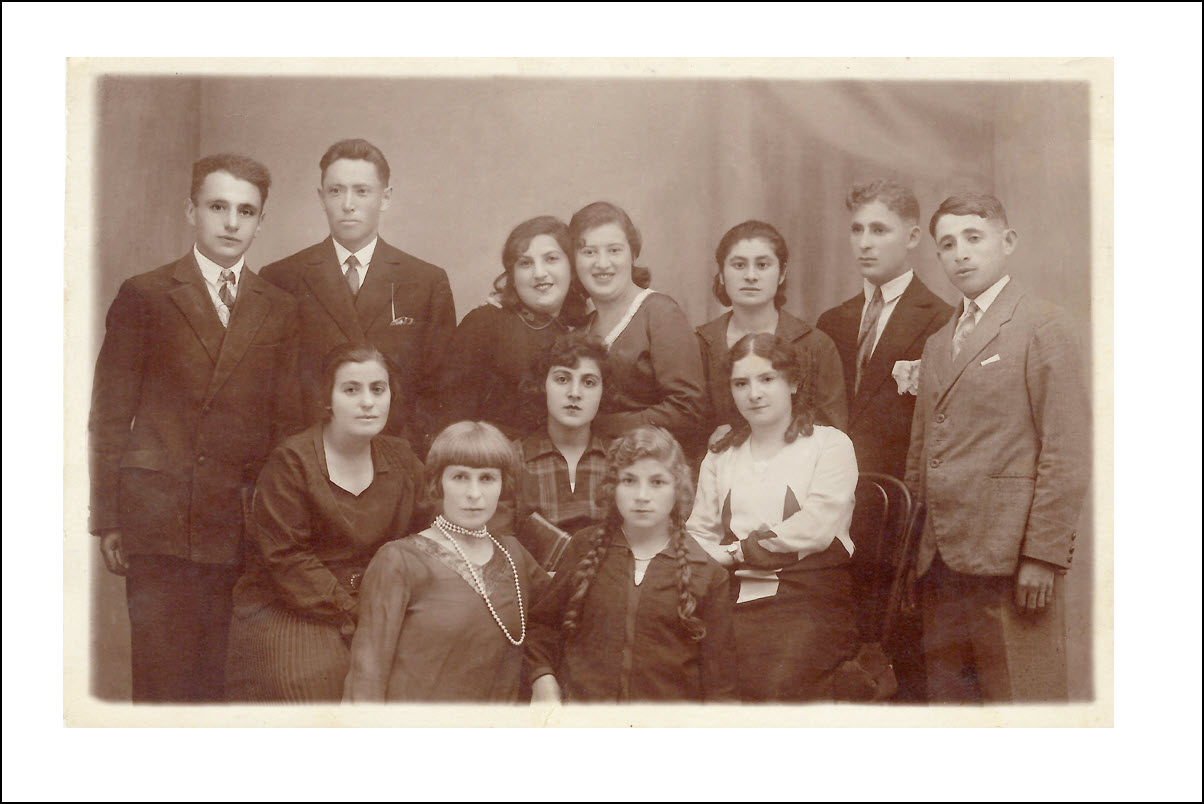 Photos of Lipa (standing left) next to his cousin Yosef Ganon (called Kufta Gertnich in Mlynov) with the family of his aunt Sorke Gertnich (nee Shrentzil).[3] Courtesy of Miriam Aharoni.
Photos of Lipa (standing left) next to his cousin Yosef Ganon (called Kufta Gertnich in Mlynov) with the family of his aunt Sorke Gertnich (nee Shrentzil).[3] Courtesy of Miriam Aharoni.Lipa's parents and siblings were tragically killed in the Shoah. He only became aware of the circumstances of their death from a letter from his first cousin, Shaul Halpern, who managed to survive the mass killing. Shaul was then in a displaced person camp in Germany, and later he migrated to Canada. Miriam tells me that "the murder of her father's family and the community did not give her father rest until his last day."
Shaul was born on May 15, 1912 in Mlynov to Joseph (Yosef) Halperin and Cipa Rywiec (possibly a variation of Rivitz). They had six children: Ada (1903), Roza (1905), [another] Lipa (1906), Aron (1908), Saul (1912), and Benjamin (1914). All of Saul's siblings and his mother perished in the Shoah, except for Benjamin who left for Russia in 1939, as a bookkeeper, and never left Russia. Benjamin is the very tall man in the Hirsch home movie taken in Mlynov in 1935. Benjamin married but had no children. He died in Leningrad in September 1986.
I learn from Saul's daughter, Arlene, that the iron curtain was lifted too late for the brothers to ever meet again face to face but they did reconnect and exchange letters. She continues:
Saul was a member of a Zionist youth group in Mlynov. In this photo below, he is in the back row third from the left. His house was on a street called Rynkowa, which was the Main Street in town. It was a large house with a store front where his family conducted business."
Saul and his siblings stayed in Mlynov to support their mother who was a widow but in 1943 Saul ran away. He hid on the farm of a gentile school friend's parents in a hole buried in their barn. He hid until 1944 when the Russians freed the town. The Russians conscripted him into their army where he remained until the end of the war. He did return to Mlynov after the war. From there he was sent by Betar to a DP camp in Pocking, Germany as an administrator to head the education department. In Pocking he met, Leah Fijalkow, who was from Pinsk. They married in 1946 and had a daughter, Arlene (Halpern) Leder. In 1949, the family immigrated to Toronto, where Saul was offered a position as a Hebrew teacher at the Associated Hebrew Day School in Toronto.
You can download the full-length version of the Hirsch family saga, or to the beginning of the Hirsch story.
***
Notes
[1] From Jacob standing center, continuing clockwise, the children: Hyman (Leo), Sophie, Benjamin, brother Isaac (Isadore) Newman and his wife Lena (Goldstein), Harry and Abraham. ↩
[2] Top Row (l t r) Isaac (eldest Hirsch brother), Abraham (A. D.), Jacob (J. G.), Lewis (L. A.), Yankle Gurtin, Saul Gurtin (Yankle's son), Nathan Kotler. Middle row (l t r): Ellen Hirsch (Abe's wife), Clara Hirsch (Jacob's wife), Fannie Hirsch (Lewis's wife), Ruchel Gurtin (oldest Hirsch sister), Jeannete (youngest Hirsch sister), Annie Kotler (Nathan's wife) Front row (l t r): Sondra Hirsch, Edward Hirsch, Gloria Hirsch. An article in the Jersey Journal (Oct. 4, 1949) identifies Norman Kotler as an employee of Standard for 16 years. ↩
***
Compiled by Howard I. Schwartz
Updated: July 2024
Copyright © 2021 Howard I. Schwartz, PhD
Webpage Design by Howard I. Schwartz
Want to search for more information: JewishGen Home Page
Want to look at other Town pages: KehilaLinks Home Page
This page is hosted at no cost to the public by JewishGen, Inc., a non-profit corporation. If it has been useful to you, or if you are moved by the effort to preserve the memory of our lost communities, your JewishGen-erosity would be deeply appreciated.
- History
